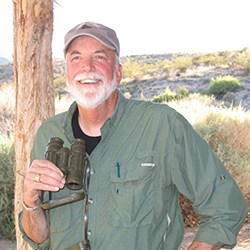Share this article
TWS’ premier journals plan new initiatives
The Wildlife Society’s leading peer-reviewed journals — the Journal of Wildlife Management and the Wildlife Society Bulletin — have exciting new initiatives and plans to increase submissions and the Society’s impact on the science behind wildlife management and conservation.
Last fall, Paul Krausman, new editor-in-chief of JWM, and David Haukos, new editor-in-chief of WSB, met with journal publishers Wiley to learn about the latest publishing trends. The meeting generated a list of initiatives that the two editors are jointly working on.

Paul Krausman, new editor-in-chief of the Journal of Wildlife Management, has developed several new initiatives to expand the reach of the journal, which has an impact factor of 1.726.
“JWM is one of the premier journals for wildlifers and my vision is for that reputation to grow internationally as wildlife management and conservation expands worldwide,” Krausman said.
As part of that vision, the JWM editor has developed a volunteer program to provide help to authors whose first language is not English. In addition, the journal will run several reviews on contemporary topics in the wildlife profession including impacts of climate change on wildlife as well as captive management issues such as deer farming to expand the journal’s value as a peer-reviewed publication.
Similarly, Haukos hopes to further engage wildlife professionals in developing meaningful content for WSB and, in the process, expand its influence in North America and around the world as the principle source of information for wildlife conservation and management.
“The Wildlife Society Bulletin represents a leading source of information for the wildlife practitioner,” Haukos said. “Managers, policy makers, regulators and conservation planners should look to the Bulletin for knowledge based on rigorous science to assist in decision making.” WSB also has several special sections in the works including the March 2016 issue on captive cervid management and another on long-term population monitoring that’s scheduled for March 2017.

David Haukos, new editor-in-chief of the Wildlife Society Bulletin, associate professor at Kansas State University and Kansas Cooperative Fish and Wildlife Research Unit leader — plans to develop meaningful content to further engage wildlife professionals.
Both editors also have developed uniform author guidelines that will help clarify submission questions and improve the peer-review process. In addition, Krausman recently published an editorial highlighting key distinctions between the two journals to help scientists identify the most appropriate avenue for their research. Haukos has published a similar editorial outlining the distinctions.
“Each journal has a different mission,” said Krausman. “Because both journals have always addressed wildlife management, there will be some necessary overlap. For example, both journals include commentaries, reviews, special sections, economics and human dimensions related to the core topic areas for each journal.”
“In general, however, WSB focuses on evaluations of management actions and JWM focuses on wildlife relationships that can lead to management and conservation recommendations,” Haukos said.
Krausman notes that in most cases the proper outlet is straightforward. But some papers, however, will contain material appropriate for both journals. In those cases, Krausman and Haukos say that authors should revise the paper into two separate, but somewhat different papers, or submit it to the journal that reflects the major emphasis of the paper. They note that the areas that confuse most authors are those that are related to the management and conservation of wildlife.
Krausman and Haukos encourage TWS members to submit papers to JWM and WSB to continue the Society’s strong tradition of publishing peer-reviewed wildlife science. In the most recent JWM, Krausman also offered authors practical tips on promoting their published research to a broad audience by using key words, for example, and including a clear and succinct abstract.
Members can sign up to receive automated, email alerts containing the table of contents of each new issue or browse all the early-view papers and past issues on Wiley’s online library for each journal: JWM and WSB. More information is also available on the publications’ page of the TWS website.








